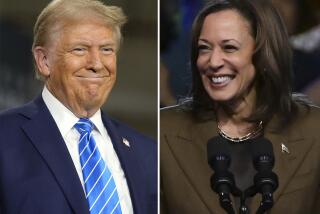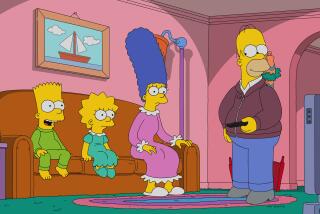Looking to History, Pundits Never Saw This One Coming
WASHINGTON — Pundits and pollsters filled the airwaves last weekend with their election predictions. They talked of races too tight to call, a Senate likely to stay in Democratic hands and a president without coattails.
Instead, Republicans have picked up five seats in the House so far, and two in the Senate, recapturing that chamber with a 51-47 margin that could improve next month if Sen. Mary Landrieu (D-La.) loses a runoff.
The predictions now seem ludicrous, even among those with an ax to grind.
“George Bush has never had coattails,” Democratic National Committee Chairman Terry McAuliffe said Sunday on NBC’s “Meet the Press.” By stumping at 90 campaign events and putting his prestige on the line, President Bush “made a strategic error,” McAuliffe said.
McAuliffe’s bluster can be dismissed as the expected cheerleading of a partisan spinner, part of a party leader’s job. But what of the journalists and pollsters paid to exercise independent judgment? Why did they miss the Republican victories?
Robert Blendon, a political analyst who directs Harvard University’s Opinion Research Program, thinks the chattering class failed to see the trend because they were seduced by history. Except he thinks they were looking at the wrong textbooks.
Conventional wisdom holds that presidents always lose votes in Congress in their first midterm elections. But Franklin D. Roosevelt picked up seats the year after the Japanese attack on Pearl Harbor, and John F. Kennedy picked up seats the month after the Cuban missile crisis. The Sept. 11 terrorist attacks may have had a similar effect on this year’s electorate.
“The pundits should have been more alert to the possibility of a different history,” Blendon said. “After an attack, people want to make the president strong.”
Pollsters also seemed to have blinders on, oblivious to the size of the spreads. Most polls had Florida’s Republican Gov. Jeb Bush in a tight race against Democratic challenger Bill McBride, within the 4-percentage-point margin of error. He won running away, 56% to 43%. Ditto in Georgia, where everyone said Democratic incumbent Sen. Max Cleland would triumph but Republican Rep. Saxby Chambliss took it, 53% to 46%. Then there’s Elizabeth Hanford Dole, the Republican candidate in North Carolina’s Senate race, who was said to be clinging to a shrinking lead. She beat Erskine Bowles, 54% to 45%.
“We try to portray polling as a science, but it’s a witchcraft kind of art,” said Norm Ornstein, a political scholar at the American Enterprise Institute. “When it comes to the midterm elections, we’re trying to predict how 35% of the electorate will vote, but we don’t know which 35% will turn out. It’s beyond embarrassing.”
More distressing, he noted, is that there seems to be no penalty for punditry that misses the mark. Like former football players trying to call the Super Bowl or Wall Street analysts paid small fortunes to forecast the market, political pundits are seen as feeding the cultural imperative to fill the airwaves by predicting the unpredictable: human behavior.
“It’s the sin of broadcasting in the modern age,” Ornstein said. “No matter how wrong you are, the punishment is you get your own show on cable television.”
To hear the pollsters tell it, their mistakes were less in the numbers than in the air.
“I don’t want to sound like an apologist, but there’s a pack mentality,” said Jennifer Duffy, who tracked Senate campaigns for the Cook Political Report. “Over the weekend there started to be this Democratic buzz and little data to back it up.”
ABC News predicted in its online note that Dole was in trouble. The Washington Post hinted at a Democratic tilt, in Duffy’s eyes. And polls were all over the map. In Minnesota, a poll commissioned by the St. Paul Pioneer Press and Minnesota Public Radio had Republican Norm Coleman up by 6 points, while the Minneapolis Star-Tribune poll predicted Democrat Walter F. Mondale by 5 points. With 98% of precincts reporting, Coleman was leading, 50% to 47%.
“There are widely divergent polls because everybody with three telephone lines thinks they’re a pollster,” she said.
The lack of scientific credentials or professional standards for pollsters is a concern to critics. Ever since the 1948 presidential election, when pollsters stopped talking to voters three weeks before the election and called it for Republican Thomas E. Dewey, the ghost of Harry S. Truman (along with the famous and erroneous Chicago Tribune headline proclaiming “Dewey Defeats Truman”) has haunted pollsters and journalists.
But even within the cadre of professional pollsters, there is growing concern about the ability to do credible polls in a cynical age.
John Zogby, a pollster who gained a near Zeus-like status in political circles with his all-alone prediction in 1996 that Pat Buchanan would win the New Hampshire primary, says that when he got into the business in 1984, he could count on a healthy response rate from voters he called. “When I started, two of every three voters would answer the poll,” he said. Now, angered by telemarketers and less impressed by a long-distance call, more voters are hanging up. Response rate is shrinking, and with it, credibility.
“If the response rates go under 20%, it will be impossible to claim that we have a representative sample,” Zogby said.
Zogby missed some races Tuesday -- “I really blew it in Colorado,” he notes, where he picked Democrat Tom Strickland to win by 49% to 44%, and in fact Republican Wayne Allard took it away, 51% to 45%.
But pollsters did much better on a national barometer of public opinion called generic national polling. Calculated to take the national pulse, the ballot asks voters, without naming names, whether they would prefer a Republican or a Democrat in Congress. A Gallup Poll over the weekend for USA Today and CNN found that in House races, likely voters preferred Republicans to Democrats, 51% to 45%.
Tom Edsall, a veteran political reporter for the Washington Post, got an e-mail Monday from Anthony Fabrizio, the pollster for Bob Dole’s 1996 presidential race who now does GOP polling at Fabrizio, McLaughlin & Associates. In it, the firm predicted Republicans would emerge with a 51-49 majority.
Edsall promptly e-mailed back, saying he had as much faith in Fabrizio’s predictions as he did in a poker hand.
More to Read
Get the L.A. Times Politics newsletter
Deeply reported insights into legislation, politics and policy from Sacramento, Washington and beyond. In your inbox three times per week.
You may occasionally receive promotional content from the Los Angeles Times.










